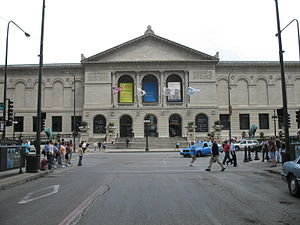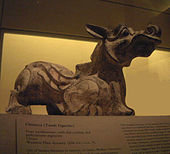Introduction
This is an internationally recognized art museum. It was started as an academy in 1866. This institute underwent rapid changes by advancing quickly to become both a school and art museum in 1879.
The Art Institute of Chicago (AIC) is a renowned institution offering a wide range of services to the public. Apart from archiving art objects from all over the world, it is equipped with an art library and an art school. In addition, this institute offers facilities for art exhibitions. In Chicago, the art history has been enlightened by the presence of this institution.
Factual and statistical information
The AIC is located in Chicago’s Grand Park in the United States. In 1866, the Chicago Academy of Design was established. This academy was financed by the patron’s donations and the members’ contributions. The academy offered art exhibitions and classes. This organization grew in size and by 1870; it had managed to purchase its own house.
This came with increased classes on art programs. In 1971, a fire outbreak destroyed the new building and consequently plagued the organization with financial problems. In the year 1878, the top management came up with a board of trustees with the aim of stabilizing the organization. The institution was rebranded as the Chicago Academy of fine arts.
The institution’s supervision changed to city elites from the organization of artists. Consequently, the name was again changed to the Art Institute of Chicago headed by a president. The major financiers of this institution were the cities’ businesspersons. They also offered management skills in the running of the institution.
AIC is the second largest art museum in the United States. It is approximately one million square feet in size. The oldest building in the institution namely the Beaux Arts building was opened in 1893 to host the World Columbian Exhibitions. Several additional structures were constructed to cater for the growth of the institution. Burnham & Ryerson Libraries were constructed in 1901 by Coolidge, Rutan and Shepley.
In 1924, Hodgdon & Coolidge constructed McKinlock Court. Howard Van Doren Shaw designed the Goodman Theater in 1926. Another important structure is the Ferguson Building of 1958 by Burgee, Root & Holabird. The Morton Wing, designed by Metz, Shaw, & Assoc. also became part of the institutions’ structures in 1962. In 1977, Columbus Drive and School of the Art Institute were added to the institutions’ structures.
Skidmore, Merrill & Owings built these structures. The Ada Rice & Daniel F. Building of 1988 was designed by Beeby, Babka & Hammond. It was also another important structure of the institution. Two more structures namely the Fullerton Hall Restoration and Modern Wing of 2001 and 2009 respectively are the latest of the additional infrastructure of the institution.
The architectural form and ground plan
The Art institute of Chicago is one of the major historical landmarks in Chicago. Most of the available photos of Chicago recognize the uniqueness of this institution. The main entrance is designed artistically with two huge carvings of bronze lions. These lions were designed by Edward in 1894. The lions are placed in such a way that one is on the southern side while the other is on the northern side of the gate. This institution is situated at the top of the ruins of the greatest fire ever experienced in Chicago.
The main building, Beaux-Arts building, is the oldest and it is located after the main entrance. Several buildings are located inside the gate of the institution. They total up to 273 galleries that cover 52,200m2. At the central section of the compound is the Italian facade. This building hangs forward in such a way that 7-Bayes of wings can be seen on either side. The entry into the institution has a lane of acacia tree that directly leads to the three outstanding Palladian arches.
The northern side has the Fullerton Hall. On the main floor of this building, there is an open court. This building is made up of domes that have stained glass. The building has a capacity of 425 people who can be accommodated in one sitting. The Ryerson Library is located opposite to the Fullerton Hall on the southern part of the compound. It is also an open court. Another significant architectural design in this institute is the Gunsaulus Hall.
It is a two-story bridge spanning the central railroad tracks at the back of the Beaux-Arts building. Adjacent to the Beaux-Arts building on the eastern side is the Blackstone Hall. This hall is divided into several small galleries. The administration offices of this institution are found in the Benjamin F. Ferguson Memorial Building. The southern side of the compound has the Morton Wing its location ensures symmetry in the Ferguson’s building. It hosts several galleries apart from offering more exhibition space.
The Rubloff Building situated close to the open grounds houses rooms used for classes, the open viewing museum, a film center, and studios used to conduct art activities. The Modern Wing is the largest buildings in this institute, it was opened in 2009. It has increased the galleries by 30 percent. It also houses the Ryan Education Center. It is designed with ultra modern green technology that allows the use of sunlight in most of the rooms.
The Stanley McCormick Memorial court is a beautiful garden located in the northern side of the institute. The southern side has the fountain of the great lakes. Several other gardens and landscapes are located inside the facility’s gates.
Contents of museum
This museum is specialized in collecting post-impressionist and impressionist art. These are permanent collections of the museum. The collected works contain over 5000 works from different cultures and expressions. It contains over 260,000 different types of art. It has the oldest artistic paintings such as the early Japanese art as well as modern paintings.
Some of the impressionist and post-impressionist paintings include paintings by Claude Monet, Pierre-Auguste Renoir, Paul Cézanne, Henri de Toulouse-Lautrec, and Gustave Caillebotte. There are also non-French paintings of the impressionist and non-impressionist art in the galleries of the museum. Great American art is also exhibited in the museum. Examples of these great artists include Mary Cassatt, Grant Wood, and Edward Hopper.
There are several other works that are present in the museum apart from the paintings. The Asian and European furnishings and the designs are located in the Thorne small temporary housing. Several pieces of American furniture are found in the gallery of American decorative art.
Most of the pieces of furniture are from the middle ages to the mid 20th century. Furthermore, the museum has the finger gallery for the visually impaired people. These galleries exhibit fine Braille art that is experienced through the sense of touch. In addition, other galleries contain very old artifacts from the Egyptian, Roman, and Greek kingdoms such as gold coins and mummy.
The most comprehensive representation of the American art is found in the Terra collections. This gallery exhibits collections of American art done by the Terra foundations. In addition, the African American gallery is also an important historical gallery of the group. This section exhibits several arts that display how Africans were segregated based on racial lines. Generally, this museum has a collection of artistic information that brings art back to life. It is therefore one of the richest art collections in the world.
Museum’s outreach to the general public
The main purpose of the art institute of Chicago is to educate and motivate the public. Its entire collection is used to ensure that the latter purpose is achieved. It is therefore an educational institution that has specialized in the field of art. Its main goal is to educate the public on matters regarding art.
This is achieved through various means. For instance, the museum has an art institution that welcomes any individual that has passion and wants to study art. This institution is funded partly by the museum and the contributions collected from well wishers. Several educational programs offered at this institution assist several artists to build their talents.
Furthermore, this institute serves the community through various outreach programs, free access to public spaces within the museum, and also free access to the galleries. Several educational outreach programs are conducted by the museum. Such educational programs include hosting school groups, charity donations, and supporting the local cultural groups. The institute serves about 82,000 students annually. Most of these students are drawn from the public schools in Chicago.
Several facilities within the museum can be accessed by members of the public without any charges. The southern and northern backyards are usually open during the dry seasons. Members of the public are also provided with free training programs by the Ryan Education Center. The programs offered include library, studio spaces, and galleries. The libraries are open to students, families, and children. The students are allowed to borrow the resources found in the library section.
The Bluhm Sculpture on the third floor modern wing is also free to public access. Apart from the revolving displays of monuments, it presents a perfect position for viewing the skyline. The museum is also an important affiliate of the Museum in the park. This organization is based in Chicago. It is dedicated to providing excellent and diverse learning experiences, inspiring the society, and luring tourists. All these are commitments that ensure the community gains a lot from the museum as part of their treasured assets.
The institute has made it a lot easy for the public to access its services through a detailed website. This website highlights the available arts, major events, current exhibitions, and all the other activities conducted by the museum. Moreover, the institution provides floor plans and brochures that are available online as well as in hard copies at the main office. These ensure ease of access to the services offered by the institution.
Illustrations
Fig. 1: A Painting from the Permanent Section

Antoine Watteau, Pastoral Gathering (1718)
Fig. 2: the Beaux-Arts building

Fig. 3: Fountain of the Great Lakes

Fig. 4: The Modern Wing, 2009

Fig. 5: Tomb Sculpture

A Han Dynasty tomb sculpture of a creature